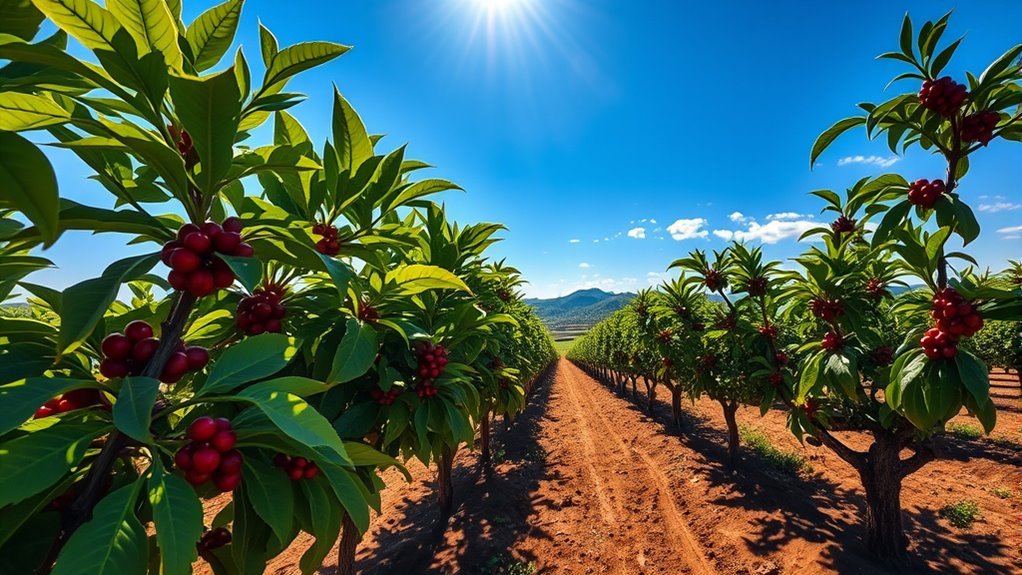Can You Grow Coffee in Texas
Yes, you can grow coffee in Texas! To succeed, you’ll need to choose the right hybrids that can withstand the state’s unique heat and humidity. Utilizing shade-grown techniques and precise irrigation methods is essential for promoting growth. While challenges like climate variability and pest control exist, successful farms exemplify resilience and innovation. Exploring the local coffee culture not only enhances your knowledge but also reveals the rich flavors that Texas coffee can offer.
Overview of Coffee Cultivation
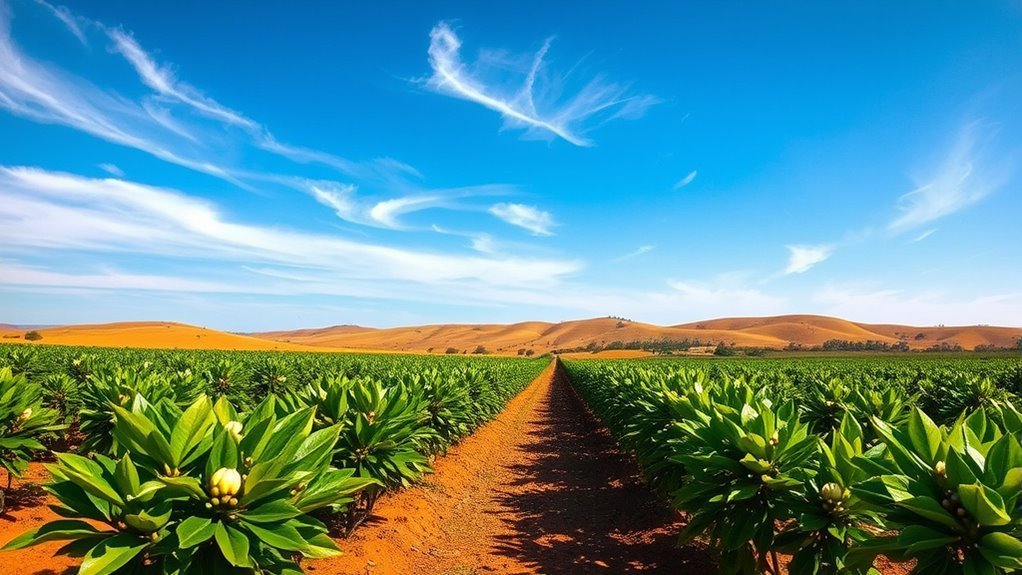
When you think about coffee cultivation, you might picture lush, tropical landscapes far from Texas, but growing coffee can actually be feasible in certain parts of the state. The history of coffee spans centuries, and understanding its roots helps you appreciate the art of cultivation. Traditional techniques often involve shade-grown methods, which promote biodiversity and enhance flavor profiles. You’ll find that Texas coffee growers are experimenting with these methods, adapting them to local conditions. Whether it’s selecting the right coffee varieties or implementing effective irrigation strategies, mastering cultivation techniques is essential for success. By embracing this agricultural adventure, you’re not just growing coffee; you’re participating in a rich tradition that connects you to a global community of coffee enthusiasts.
Texas Climate and Its Suitability for Coffee
Understanding the climate in Texas is essential to determining whether you can successfully grow coffee. While you might be excited about the idea, you’ll need to take into account temperature variations across the state. Coffee thrives in mild, stable climates, ideally between 60°F and 70°F. In Texas, regions with these temperatures can be limited, but innovative coffee growing techniques can help mitigate extreme conditions. For instance, planting in shaded areas or using protective structures can help shield your plants from harsh heat and cold snaps. Additionally, understanding soil moisture and humidity levels will play a vital role in your success. By carefully selecting your location and employing effective techniques, you can explore the possibility of growing coffee in the Lone Star State.
Coffee Varieties That Thrive in Texas
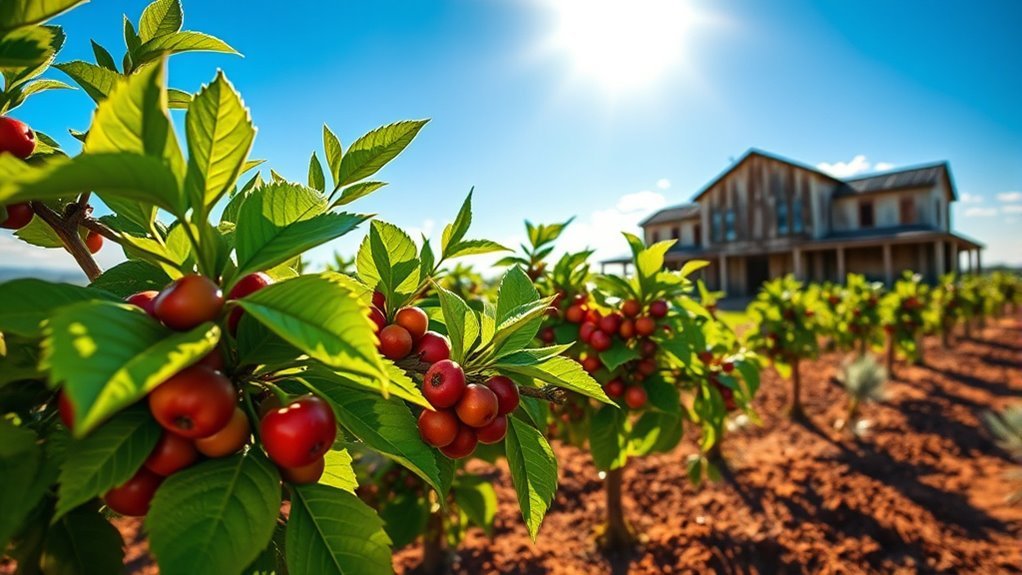
Which coffee varieties can truly thrive in the unique climate of Texas? If you’re looking to cultivate your own beans, consider the Texas hybrid coffee. These coffee plant varieties are specifically bred to withstand Texas’s heat and humidity, making them more resilient than traditional types. Varieties like the Arabica and Robusta hybrids are particularly popular, as they adapt well to the local conditions while still delivering great flavor. By choosing the right Texas hybrid coffee, you can enjoy a robust cup that reflects the essence of your environment. Not only do these varieties flourish, but they also offer a sense of freedom and independence, allowing you to savor your own homegrown brew in the Lone Star State.
Successful Coffee Farms in Texas
When it comes to growing coffee in Texas, unique climate considerations play an essential role in determining success. You’ll find several notable coffee farms that have adapted to these conditions, showcasing impressive techniques and varieties. Exploring their stories can shed light on what makes coffee cultivation feasible in the Lone Star State.
Unique Climate Considerations
Although growing coffee in Texas may seem unlikely, several successful coffee farms have proven that the state’s unique climate can be surprisingly conducive to cultivation. The key lies in understanding microclimate effects, which create pockets of favorable conditions for coffee plants. Areas that receive morning sun but are shaded in the afternoon can promote healthy growth while minimizing heat stress. Effective pest management is also essential; Texas farmers often employ organic methods to combat pests, ensuring their crops thrive without harmful chemicals. By leveraging these strategies, you can harness Texas’s diverse climate to produce high-quality coffee. So, if you’re considering a coffee venture, embrace the unique challenges and opportunities that Texas offers!
Notable Texas Coffee Farms
Texas is home to several notable coffee farms that showcase the state’s potential for coffee cultivation. One standout is the Lone Star Coffee Company, located in the heart of the Hill Country. Their unique approach blends traditional methods with modern techniques, resulting in rich, flavorful Texas coffee. Another gem is the Texas Coffee Company in Waco, which emphasizes regional differences by sourcing beans that thrive in various Texas microclimates. These farms not only produce high-quality coffee but also educate consumers about the intricacies of coffee cultivation. By visiting these farms, you’ll gain insight into the artistry and dedication behind every cup, celebrating the freedom of local craftsmanship in the ever-evolving world of coffee.
Challenges of Growing Coffee in Texas
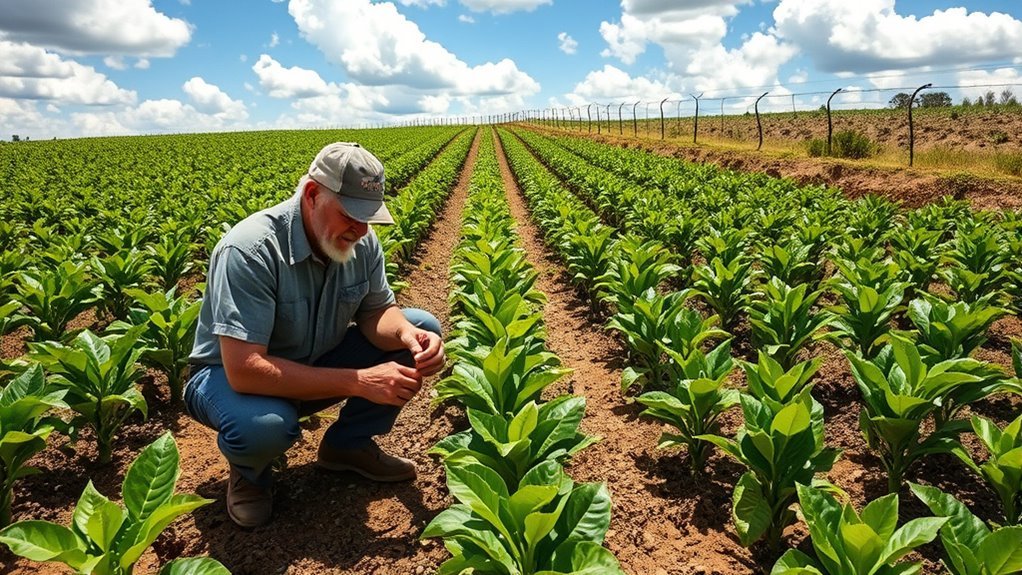
Growing coffee in Texas presents a unique set of challenges that can make the endeavor both rewarding and frustrating. If you’re considering this journey, here are three key hurdles you’ll face:
- Climate Variability: Texas weather can be unpredictable, with extreme heat and occasional frost that can damage your coffee plants.
- Pest Control: Coffee crops attract various pests, and managing them without harsh chemicals can be tricky.
- Market Demand: While there’s a growing interest in locally-sourced coffee, the competition is fierce, making it essential to establish a solid market presence.
Navigating these challenges requires resilience and creativity, but overcoming them can lead to a fulfilling and profitable coffee-growing venture that aligns with your passion for freedom and sustainability.
Soil Conditions and Requirements
When you’re considering growing coffee in Texas, the soil’s pH, drainage, and nutrient content become critical factors. Ideally, coffee thrives in slightly acidic soil with good drainage to prevent root rot. You’ll need to guarantee your soil is rich in organic matter to provide the nutrients essential for healthy coffee plants.
Ideal Soil Ph
For ideal coffee growth, maintaining an ideal soil pH between 6.0 and 6.5 is essential. To guarantee your soil is right for coffee, consider these key steps:
- Conduct pH testing: Regularly check your soil’s pH to identify any imbalances.
- Add soil amendments: Depending on your test results, you might need to incorporate lime to raise pH or sulfur to lower it.
- Monitor regularly: Keep an eye on your soil’s health to make adjustments as needed.
Drainage and Nutrients
Successful coffee cultivation in Texas hinges on two critical factors: drainage and nutrient availability. You need to implement effective drainage techniques to prevent waterlogging, which can lead to root rot and hinder plant growth. Consider raised beds or well-draining soil amendments to enhance water flow.
Nutrient management is equally essential. Coffee plants thrive in nutrient-rich soils, so regular soil testing can help you determine what fertilizers to apply. Organic options, like compost and worm castings, can improve soil structure and nutrient content without chemical additives. Balancing these elements will create an environment where your coffee plants can flourish. By focusing on proper drainage and effective nutrient management, you’ll set the foundation for a successful coffee-growing venture in Texas.
Irrigation and Water Management
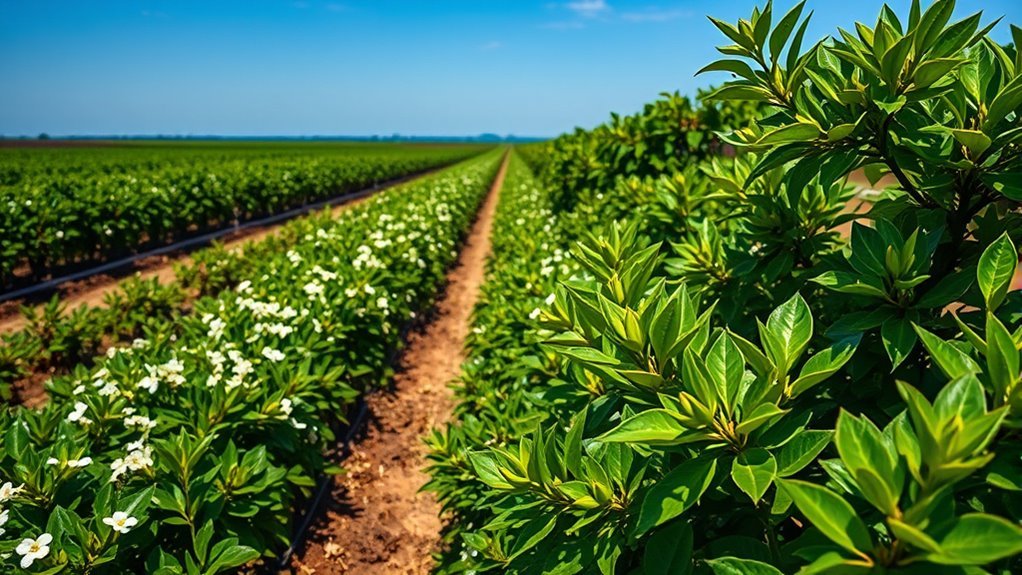
While growing coffee in Texas can be a rewarding endeavor, effective irrigation and water management are essential for ensuring healthy plants and ideal yields. To achieve this, consider these strategies:
Effective irrigation and water management are crucial for thriving coffee plants and maximizing yields in Texas.
- Drip Irrigation: This method delivers water directly to the roots, minimizing waste and ensuring consistent moisture levels.
- Rainwater Harvesting: Capturing rainwater can provide a sustainable water source, reducing dependence on municipal supplies and lowering costs.
- Soil Moisture Monitoring: Regularly check moisture levels in the soil to avoid over- or under-watering, which can stress your plants.
Harvesting and Processing Coffee in Texas
Once your coffee plants reach maturity, understanding the nuances of harvesting and processing is essential to achieving the best flavor profile. You’ll find that employing the right harvesting techniques, such as selective picking or strip harvesting, can greatly influence the quality of your beans. Selective picking allows you to choose only the ripe cherries, ensuring ideal flavor, while strip harvesting can be more efficient but may result in uneven quality.
After harvesting, processing methods like the washed or natural process come into play. The washed method removes the fruit before fermentation, leading to a cleaner taste, while the natural method dries the cherries whole, imparting fruity notes. Each choice shapes your coffee, so consider your desired flavor profile carefully!
The Future of Coffee Farming in Texas
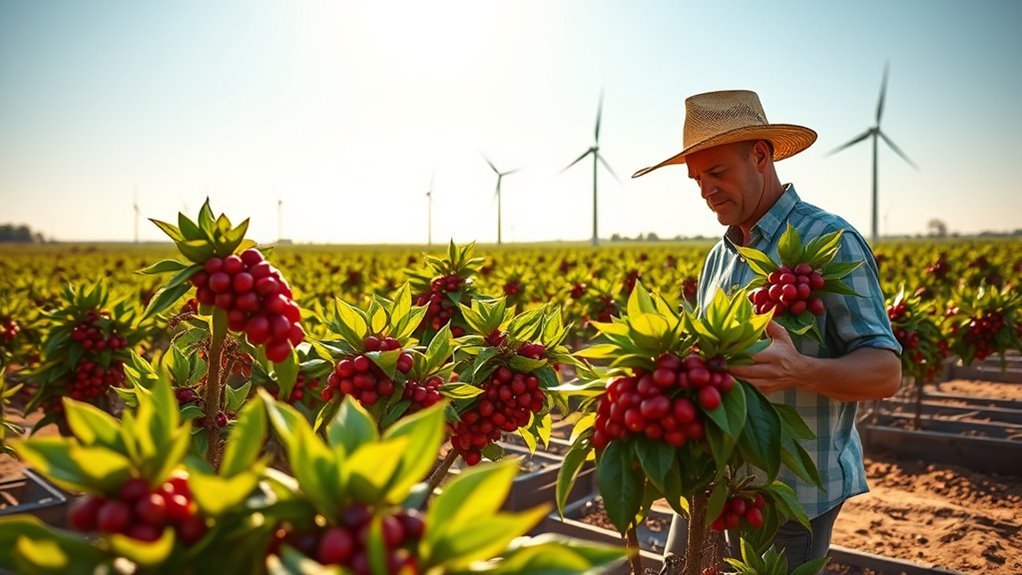
As Texas coffee farming evolves, growers are increasingly focused on adapting to climate challenges and embracing innovative practices. To thrive in this dynamic landscape, you can expect to see:
- Sustainable practices: Farmers are integrating eco-friendly methods, reducing water usage, and enhancing soil health.
- Future innovations: Technology, like precision agriculture and climate-resistant coffee varieties, is being adopted to boost yields and quality.
- Community engagement: Collaborations among local growers, researchers, and consumers are shaping a more resilient coffee culture.
With these advancements, Texas coffee farming can not only survive but flourish. By prioritizing sustainability and innovation, you’re paving the way for a vibrant future, allowing you the freedom to enjoy local coffee while supporting a responsible agricultural landscape.
Unique Flavors of Texas-Grown Coffee
When you sip a cup of Texas-grown coffee, you’re not just tasting a beverage; you’re experiencing a unique blend of flavors that reflect the state’s diverse climate and rich soil. Texas coffee offers intriguing flavor profiles, influenced by its varying elevations, rainfall, and soil types. You might find hints of chocolate, citrus, or even floral notes, each cup telling a story of its origin. Regional blends showcase the distinct characteristics of different areas, from the Hill Country’s nutty undertones to the East Texas beans with their earthy richness. As you explore these flavors, you’ll appreciate how Texas coffee cultivators are carving out a niche, celebrating freedom in coffee production and inviting you to savor every sip.
Frequently Asked Questions
What Are the Best Regions in Texas for Coffee Cultivation?
When exploring the best regions in Texas for coffee cultivation, you’ll find areas like the Hill Country and parts of East Texas particularly promising. These regions offer suitable climates for various coffee varieties, especially if you use innovative cultivation techniques that adapt to local conditions. Embracing the freedom to experiment with shade-grown methods or organic practices can enhance your yield and quality, making your coffee-growing journey both rewarding and enjoyable.
How Long Does It Take for Coffee Plants to Produce Beans?
Growing coffee is like nurturing a dream; it takes time and patience. Generally, you’ll find that coffee plants need about three to four years to produce beans. During this period, the coffee growth timeline involves meticulous care and the bean maturation process, where flowers bloom and eventually develop into cherries. Once harvested, it’s another journey to extract those beans that’ll become your morning brew, but the wait is well worth it!
Can Coffee Plants Survive Texas Winters?
Can coffee plants survive Texas winters? It’s a challenge, but with proper coffee plant care, it’s possible. You’ll need to provide winter protection, like covering your plants with frost blankets or moving potted plants indoors during cold snaps. Remember, coffee plants thrive in warmer climates, so when temperatures drop, they can suffer. By taking these steps, you can enjoy your coffee plants year-round and embrace the freedom of growing your own beans!
What Pests Are Common in Texas Coffee Farming?
Imagine a lush coffee grove, sunlight filtering through the leaves, yet pests lurk like shadows, threatening your harvest. In Texas, common pests include aphids and spider mites. To protect your precious plants, effective pest control is essential. Consider organic solutions like neem oil or insecticidal soap, which can safeguard your coffee while keeping the ecosystem intact. Embracing nature’s balance allows you to cultivate your coffee dreams without compromising your values.
Are There Any Coffee-Growing Cooperatives in Texas?
Yes, there are coffee-growing cooperatives in Texas that focus on local farming practices. These cooperatives often emphasize sustainable methods and community support, allowing you to connect with fellow coffee enthusiasts and farmers. By joining one, you can gain insights into cultivation techniques and share resources. Engaging with these cooperatives not only enhances your knowledge but also fosters a sense of freedom in exploring unique coffee varieties suited to Texas’ climate.
